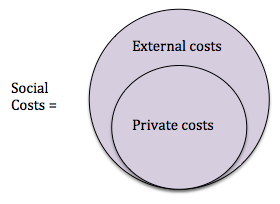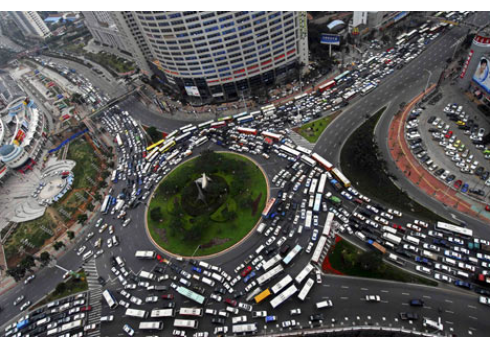Last Update: March 27, 2017

The green benefits (lower emissions etc) of an electric car may be great, but most people are also looking at the cost. Will an electric vehicle cost more to own? Will it be worth the cost difference? These questions are hard to answer accurately because some of the costs for the gasoline powered paradigm are externalized. That is, the vehicle owner doesn’t pay all the costs associated with owning the vehicle.
That’s the thinking behind the “put a price on carbon” proposal many suggest as the solution for climate change. Make the externalized costs visible, the thinking goes, and suddenly the alternatives will appear to be cheaper. We haven’t been able to run the experiment to prove or disprove this notion, but it’s an interesting idea.
As we’ve discussed elsewhere in these pages, the purchase price (MSRP) of any car is a small part of the total expense to own that car. We’ve made the case that electric cars are cheaper because there’s several expenses for gas car ownership which aren’t true for electric car ownership – such as the expensive fuel for gasoline cars, or oil changes, or routine maintenance, etc.
We haven’t really discussed the externalized cost of ownership that gasoline car owners don’t even see.
What’s an Externality or Externalized Cost?
Glad you asked.
 An externality is a side effect or consequence of an activity (industrial, commercial, etc) that forces others to spend money without being reflected in the cost of the original activity. In other words, when you buy a gizmo (car, house, refrigerator, etc) often some consequences of the manufacturing or operation of that gizmo cause other people to pay money for something. For example old-school refrigerators that leaked refrigerant that caused ozone layer damage created a cost all of us pay from environmental damage, but owners of those refrigerators did not pay that cost themselves.
An externality is a side effect or consequence of an activity (industrial, commercial, etc) that forces others to spend money without being reflected in the cost of the original activity. In other words, when you buy a gizmo (car, house, refrigerator, etc) often some consequences of the manufacturing or operation of that gizmo cause other people to pay money for something. For example old-school refrigerators that leaked refrigerant that caused ozone layer damage created a cost all of us pay from environmental damage, but owners of those refrigerators did not pay that cost themselves.
Another way of looking at this – society-as-a-whole pays a cost for each vehicle that exists. You, as the owner of a vehicle, pay a share of the whole cost. The costs you don’t pay for get paid for somewhere else, by someone else, unfairly increasing their cost of living.
Some examples are :-
- health issues coming from breathing exhaust-laden air
- land being set aside to park the vehicle
Externalized cost factors in car ownership
Now that we understand what externalized costs are, let’s look at a few.

Paying for roads and highways
The road and highway system must exist for the cars and trucks to be useful. Good roads make cars and trucks more valuable, in other words.
The roads and highways don’t poof themselves into existence out of thin air. There are high costs to build and maintain them.
In many cases the car owner doesn’t directly pay to use the roads. Instead the road system is paid for through other mechanisms, like fuel taxes or just by drawing money from the general fund. In other words, the money to pay for highways is disconnected from car ownership costs.
In the USA and perhaps elsewhere, highway system funding has been inadequate for years. A web search for “highway system funding shortfall USA” turns up news articles over a several year period warning about crumbling roads and bridges as a result.
Land use nightmare – the huge amount of land tied up in infrastructure for cars and trucks
Connected to the highway system funding shortfall is a little recognized factoid — cities cannot earn tax revenue from the land taken up by highways. It means city tax revenue per square mile is lower than it could be, simply because highways and roads and parking lots take up so much space. Those infrastructure bits are necessary not only to increase the value of our cars and trucks, but for the simple necessity of transporting goods and services and people from home to work to shopping to wherever.
Let’s tackle a simpler question – the amount of land tied up in highways, roads, parking lots, etc – and whether that’s the best purpose for that land.
 Parking: It’s thought there must be 8 or more parking spaces in existence for each car which exists. If that seems excessive, think about all the parking lots that are mostly empty most of the year. US zoning rules require enough parking to be built to handle the busiest day of the year – such as the Wednesday before Thanksgiving, or the Friday after Thanksgiving, or Christmas Eve, etc. While it’s nice that city planners are thinking ahead, it means most parking lot space sits unused most of the year.
Parking: It’s thought there must be 8 or more parking spaces in existence for each car which exists. If that seems excessive, think about all the parking lots that are mostly empty most of the year. US zoning rules require enough parking to be built to handle the busiest day of the year – such as the Wednesday before Thanksgiving, or the Friday after Thanksgiving, or Christmas Eve, etc. While it’s nice that city planners are thinking ahead, it means most parking lot space sits unused most of the year.
Parking lots cost a lot to build and maintain – perhaps $20,000 per space in a parking garage. [VTPI]
Who pays that cost? While some parking lots have parking fees, presumably enough to pay for the parking lot, many (in the US) do not. Hence every “free” parking space is paid for by someone else.
 Road surface: The more cars which exist the more road space is required. First is the road space occupied by the car itself, and second is the “safe following distance” required for human driven individual cars.
Road surface: The more cars which exist the more road space is required. First is the road space occupied by the car itself, and second is the “safe following distance” required for human driven individual cars.
I know that most ignore this rule – but human reaction time dictates the safest distance between your car and the one ahead of you must give you 2-3 seconds in which to respond to a sudden event ahead. At 75 miles/hr you’re traveling 111 feet per second, so the safe following distance is 333 feet or more.
Meaning that individually driven cars at highway speed should be separated by 300+ feet to maintain safety. Just because most ignore this rule doesn’t make it a silly rule, and perhaps this is the root cause of the many multi-car pileups.
Individually driven cars are the least efficient use of land for transporting people around town — in terms of people transported per square mile of road surface.
It’s hoped that self-driving cars can address this problem. Having a computer drive the car, rather than a human, means cars could travel closer together and therefore require less road surface to transport the same number of people.
Some other more efficient (land space required to transport people) systems are:
- Bicycling
- Motorcycles
- Bus and train mass transit
- Walking in a walkable urban area
Manufacturing and disposal of cars or trucks: Accounting for land use associated with cars, trucks, transportation, etc, is the space occupied by factories to make/distribute/sell the vehicles, as well as the land occupied by disposing of these vehicles at their end of life.
Urban heat island effect
Areas with lots of asphalt – for parking lots or highways – are well known to be hotter than areas with lots of greenery. Trees and the like lower the ambient temperature, where typical asphalt infrastructure increases the temperature. Higher temperature means higher cost for air conditioning the surrounding buildings, and perhaps contributes to global warming.
Typical asphalt interferes with absorption of rain water into the ground, depleting the water table
The usual road or parking lot is constructed to quickly channel rainwater into a storm drain, which then efficiently carries the water into the nearest river. In the natural world that water would have been absorbed by the ground, feeding the ecosystem of life. Instead the ground underneath roads and parking lots is deprived of water, causing some kind of environmental damage that I’m not sure how to describe.
The rest of the system which “efficiently directs rainwater into creeks or rivers – the concrete stormwater ditches etc – likewise starve the ground beneath our feet of the water required for nourishment.
Traffic collisions, injury, death, hospital bills, etc
Occasionally people screw up while driving, and their cars collide. It’s so common that the collisions are barely reported on the news except when it’s especially spectacular.
Obviously for the humans involved in these collisions, there are hospital bills or funeral expenses to pay. Who pays those costs?
Other collisions happen between vehicles and wildlife. There’s no human to pay a hospital bill, but instead an animal that’s lying dead along the highway. Our natural world is being deprived of the lives of those animals. What’s the cost to our environment? Who’s paying for this cost?
Greenhouse gas emissions, climate change
We went over this elsewhere – fossil fuel consumption whether it’s coal or natural gas in an electricity plant, or gasoline/diesel in a car or truck, emits a zillion negative environmental effects one of which is climate change (global warming). The car owner isn’t paying a dime for this, yet it’s a real effect impacting all of us, and it is costing our whole society a lot of money, and the costs will increase over the coming years as the impacts grow.
Cardiovascular and other ill health effects
Among the emissions from fossil fuel consumption are
gasses and particles which cause cardiovascular diseases and other forms of bad health. Lots of people are receiving health treatment who would be healthy if they weren’t breathing fossil fuel exhaust fumes. Who’s paying for those health costs?
Emotional baggage from driving on highways
I noticed several years ago that while driving in stop-and-go traffic I was more tense. At every stop, and go, maneuver there was a risk of misjudging something and colliding with the car in front of me, or having the driver behind me slam into my car, or that lane splitting motorcyclist might collide with cars, etc.
This emotional baggage might go unrecognized, it might be buried in the subconscious, but it’s there nonetheless. Especially for those of us who’ve been in seriously bad traffic accidents.
Sprawlitis means we spend more time driving than is necessary
The sprawl pattern to American cities means our destinations are spread further apart, and it means we’re going to spend more time driving in a car. That means more exposure to fossil fuel exhaust concentrations along highways. That means more exposure to the tension of driving on the highway.
Health impacts from a sedentary lifestyle
America faces an obesity crisis which causes a wide range of negative health impacts. While a big cause of obesity is the junk food diet, another big cause is being sedentary. Sitting in a car to drive here and there is sedentary, because you’re only exercise while driving is pushing pedals or turning wheels.


